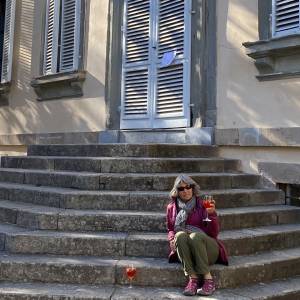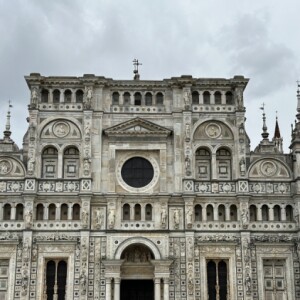Exuberance and Ascetism at Certosa di Pavia
It feels like winter! Rain, cold, grey - not optimal weather for a bike ride to the countryside as we had planned. Instead, we took the train to visit the Monastery at Certosa di Pavia. That’s another thing I love about Italy - we can take a train almost anywhere we want to go. We got off the train, walked past the industrial plant where Galbani has been making quality Italian cheese since 1882 to the high brick wall that surrounds the monastery complex. It takes about 15 minutes to walk around the wall to the front entrance. Part way around, a break in the wall allowed us a peek of the immense building (extra). We joined others in the gate house waiting for the afternoon opening. Admission is free, but we must obey the rules: NO photography, NO cell phone usage, NO dogs, NO short sleeves, NO short pants, and SILENCE! I was extremely disappointed by the first rule and happy about the last one. Our growing group of international tourists was joined by a group of high school students. In our experience, Italian school groups are always large and always produce a deafening sound. The kids did surprisingly well at keeping quiet, the adult tourists did less well on obeying the no cell phone and no photography rules. We waited behind locked iron gates until exactly 2:30, which opened up with a view of the exuberant Baroque-Renaissance facade of the church that took about 100 years to build (extra). In 1396, the political and economic interests of the first duke of Milan extended to Pavia, so he decided to build a huge Cathedral smack dab in the middle where he had a private hunting park in Certosa. The not so secret intention, was for the ornate cathedral to serve as an ostentatious family dynasty mausoleum. Several “noble” bodies are buried here and one less noble one was hidden here briefly. In August 1945, Mussolini’s mutilated corpse was found at the monastery and two Franciscan Friars were charged with hiding the body. A huge church filled with valuable art requires religious caretakers. The adjoining monastery houses the monks which have filled that role for centuries. The cloistered community has taken a vow of silence, although our monk tour guide is released from this obligation. The monks each live in a two-story cell with a garden, from which they make soaps, liquors, scents, and medicinal tisanes; all for sale in their herb shop. The featured photo shows the cloisters where the monks live. I interpreted the “NO Photography” rule to be limited to INSIDE the church, not outside.



Comments
Sign in or get an account to comment.


